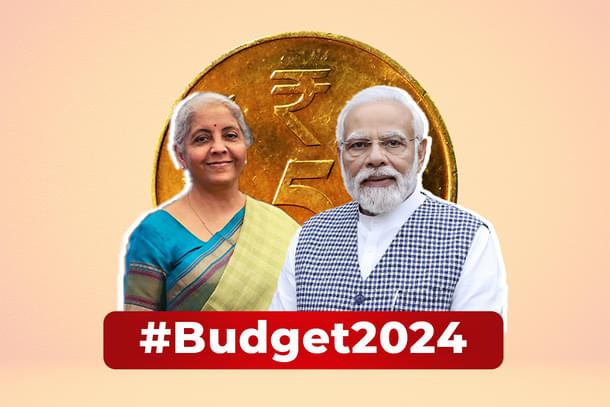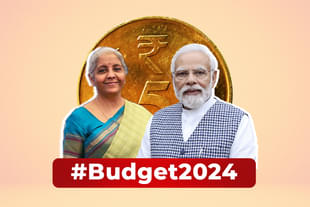Economy
What To Expect In Budget 2024-25
R Jagannathan
Jul 20, 2024, 11:57 AM | Updated Jul 23, 2024, 10:52 AM IST
Save & read from anywhere!
Bookmark stories for easy access on any device or the Swarajya app.


Most budgets, barring those presented in the midst of a financial crisis, do not make waves — except in the media. The 1991-92 budget was one such rare exception. And, barring a few others, most other budgets have been eminently forgettable. Worse, budget speeches tend to be too lengthy and dense most of the time.
So will Budget 2024-25, to be presented by Nirmala Sitharaman on 23 July, be any different?
Most people will be looking for clues to the politics underpinning the budget, coming as it does after a general election in which the Bharatiya Janata Party (BJP) suffered some setbacks and now depends on regional allies from Andhra Pradesh and Bihar to retain a parliamentary majority.
Moreover, there is a strong possibility that the BJP will reach out to more constituencies, including the poor and middle classes, to reinforce its appeal to the electorate before three major state assembly elections in Maharashtra, Jharkhand, and Haryana later this year.
While no budget will be devoid of political content, the one coming up on 23 July will probably be Narendra Modi’s most politically-loaded budget so far.
But, luckily for the government, 2024-25 is a Goldilocks year for the fisc. Revenues are buoyant, growth remains robust, the markets are on cloud nine, and private capital investments are picking up, if slowly.
The Reserve Bank of India (RBI) unexpectedly doled out a massive dividend of Rs 2.1 lakh crore, at least Rs 1.1 crore more than what the interim budget had projected.
Here are the financial contours within which budget 2024-25 will operate.
One, the RBI dividend gives the government an additional Rs 1.1 crore to do what it wants with it. In theory it could reduce borrowings (ideal), but in practice it may spend it.
Two, market buoyancy indicates that another Rs 1 lakh crore (at least) can be raised through disinvestments and strategic sales.
Take the Life Insurance Corporation (LIC), which has a current market value of over Rs 7 lakh crore. If the government disinvests just 5 per cent in this fiscal, it will get Rs 35,000 crore.
Many bank stocks are at, or close to, decadal highs, making share sales lucrative. The government’s stake sale in IDBI Bank, which it plans to divest fully, will fetch it another Rs 25,000-30,000 crore if its current market values hold up.
Three, the only economic blip is inflation, which is still around 5 per cent. This means interest costs for all will remain high, and the fiscal deficit will have to be contained at 5.1 per cent of gross domestic product (GDP) (or lower) to ensure that government borrowings do not make things worse or contribute to higher inflation.
Put simply, the government has Rs 2.1+ lakh crore to play around with, out of which it would be prudent to keep at least Rs 50,000 crore for dealing with any potential decline in revenues later this year. That leaves an amount of Rs 1.5-1.6 lakh crore to use for politically important purposes.
The demands from Andhra Pradesh and Bihar may not need too much additional cash. They can easily be met from a diversion of capital and infrastructure expenditure budgeted for the country. States that are not going to the polls immediately may see some diversions.
Also, it is worth noting that if Rs 25,000 crore worth of projects are located in Andhra and Bihar, not all of it will be spent this year.
But four major constituencies — the taxpaying middle class, the agriculture sector, unemployed youth, and the poor in general — will demand more resources. This can best be done through changes in the direct taxes regime — a part of which may flow back as revenues if the beneficiaries spend the money on goods and services — and an expansion of social security schemes like PM Kisan Samman Nidhi or Ayushman Bharat.
One should also expect an apprenticeship subsidy scheme for companies to take on youth with qualifications for skilling on the job.
The area where the budget can have maximum immediate public impact is direct taxes, so this is where a lot of attention will be focused. Since indirect taxes, mostly the goods and services tax (GST), are decided in the GST Council, only the items left out of the GST list — petroleum, cigarettes, and some layers of import duties — will find some mention in the budget.
While there is no end to demands for concessions, any sensible wishlist on the direct taxes side must include the following.
First, we must have a long-term direct taxes code that makes taxation predictable and stable. While this won’t happen in the budget coming up next Tuesday, the next best thing to do is to rationalise direct taxes in two areas, especially capital gains and tax deduction at source (TDS). This is over and above any tax cuts for the middle classes.
There are simply too many long-term capital gains tax rates, with the holding periods varying according to the type of asset held. For shares and equity mutual funds, the holding period is one year and the tax rate is 10 per cent. For property, it is two years and 20 per cent with indexation. For sovereign gold bonds, there is no capital gains tax if held to maturity. For debt, the tax rate is your tax bracket (see the full details of current capital gains rates and tenures here).
Clearly, a simplification is called for. Maybe the best way forward is to fix the holding period for long-term capital gains for all kinds of assets at three years, with the lower long-term rates applicable only for assets held for three years or more. If the holding period before an asset sale is raised to three years, the markets will not wobble. Also, the longer tenure for holding an asset means selling pressures will be lower.
Next, there are too many rates for tax deduction at source — ranging from 1 per cent to 20 per cent (check the details here). While the lower rate (for property sales, etc) is intended to force sellers to file tax returns to claim back the TDS, in most other cases, there is a need for simplicity.
If the intention is to force income earners to file returns, then 10-15 per cent should be the flat TDS rate for all incomes except property and services fees, which should be marginal.
Currently, many taxpayers who have taxes deducted at source do not file returns, which suggests that they prefer to let the money go in order to avoid the hassle of filing returns. Some two crore taxpayers do not file returns. A research study to check whether a higher TDS of 15 per cent will deliver more taxes and more returns is called for. Otherwise 10 per cent TDS in most cases will work just fine.
The principle to be kept in mind is that any change must result in at least somewhat higher tax collection, and not just an increase in returns filing. If there is a way to generate more taxes without a commensurate increase in the filing of returns, which is what TDS enables, that is better than forcing millions of people to file returns.
Third, there is clearly a case for reducing taxes for the middle classes. This can be done in two ways.
One is to raise the tax-free exemption limit for those who claim no deductions (that is, under the new tax regime) to Rs 10 lakh (from the current Rs 7 lakh). The other is to raise exemptions under the old tax regime under 80C, etc.
My personal preference is for the former, since too many item-specific deductions complicate the returns filing process. The only two deductions worth retaining are premia paid for term insurance (and certainly not all kinds of insurance, especially ULIPS and money-back policies), and medical insurance premia up to a certain limit. Since most people are already covered under the Ayushman Bharat scheme, these exemptions won’t cost much. If the idea is to really popularise the new tax regime, making the old one more attractive is hardly the way to go.
As for other priorities, the focus should continue to be on infrastructure spending, especially health and education infrastructure. In indirect taxes, which is really a challenge for the GST Council, the focus should be on reducing the number of rates and getting rid of the inverted duty structure for products that are a part of the export basket.
And, lastly, one hopes that Sitharaman keeps her budget speech short. One hour is more than enough to convey the government’s priorities to the public, with the details being left in annexures that economists and budget experts can salivate over. In her six budgets so far, only the interim budget speech earlier this year passed the short-but-sweet test.
Jagannathan is former Editorial Director, Swarajya. He tweets at @TheJaggi.





